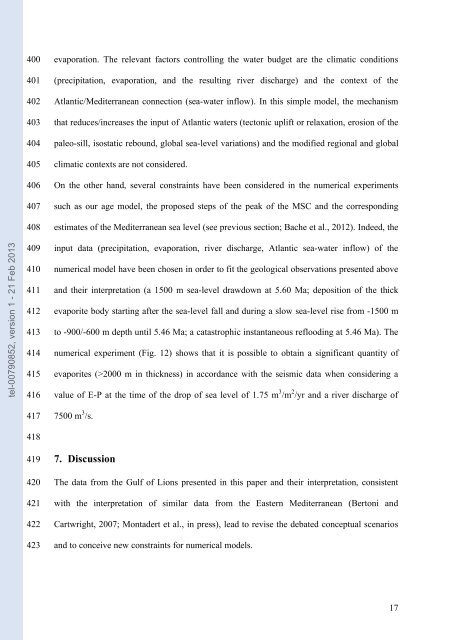Quantification des flux sédimentaires et de la subsidence du bassin ...
Quantification des flux sédimentaires et de la subsidence du bassin ...
Quantification des flux sédimentaires et de la subsidence du bassin ...
You also want an ePaper? Increase the reach of your titles
YUMPU automatically turns print PDFs into web optimized ePapers that Google loves.
tel-00790852, version 1 - 21 Feb 2013<br />
400<br />
401<br />
402<br />
403<br />
404<br />
405<br />
406<br />
407<br />
408<br />
409<br />
410<br />
411<br />
412<br />
413<br />
414<br />
415<br />
416<br />
417<br />
418<br />
419<br />
420<br />
421<br />
422<br />
423<br />
evaporation. The relevant factors controlling the water budg<strong>et</strong> are the climatic conditions<br />
(precipitation, evaporation, and the resulting river discharge) and the context of the<br />
At<strong>la</strong>ntic/Mediterranean connection (sea-water inflow). In this simple mo<strong>de</strong>l, the mechanism<br />
that re<strong>du</strong>ces/increases the input of At<strong>la</strong>ntic waters (tectonic uplift or re<strong>la</strong>xation, erosion of the<br />
paleo-sill, isostatic rebound, global sea-level variations) and the modified regional and global<br />
climatic contexts are not consi<strong>de</strong>red.<br />
On the other hand, several constraints have been consi<strong>de</strong>red in the numerical experiments<br />
such as our age mo<strong>de</strong>l, the proposed steps of the peak of the MSC and the corresponding<br />
estimates of the Mediterranean sea level (see previous section; Bache <strong>et</strong> al., 2012). In<strong>de</strong>ed, the<br />
input data (precipitation, evaporation, river discharge, At<strong>la</strong>ntic sea-water inflow) of the<br />
numerical mo<strong>de</strong>l have been chosen in or<strong>de</strong>r to fit the geological observations presented above<br />
and their interpr<strong>et</strong>ation (a 1500 m sea-level drawdown at 5.60 Ma; <strong>de</strong>position of the thick<br />
evaporite body starting after the sea-level fall and <strong>du</strong>ring a slow sea-level rise from -1500 m<br />
to -900/-600 m <strong>de</strong>pth until 5.46 Ma; a catastrophic instantaneous reflooding at 5.46 Ma). The<br />
numerical experiment (Fig. 12) shows that it is possible to obtain a significant quantity of<br />
evaporites (>2000 m in thickness) in accordance with the seismic data when consi<strong>de</strong>ring a<br />
value of E-P at the time of the drop of sea level of 1.75 m 3 /m 2 /yr and a river discharge of<br />
7500 m 3 /s.<br />
7. Discussion<br />
The data from the Gulf of Lions presented in this paper and their interpr<strong>et</strong>ation, consistent<br />
with the interpr<strong>et</strong>ation of simi<strong>la</strong>r data from the Eastern Mediterranean (Bertoni and<br />
Cartwright, 2007; Monta<strong>de</strong>rt <strong>et</strong> al., in press), lead to revise the <strong>de</strong>bated conceptual scenarios<br />
and to conceive new constraints for numerical mo<strong>de</strong>ls.<br />
17

















